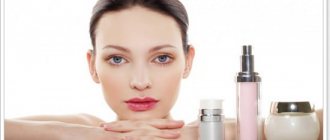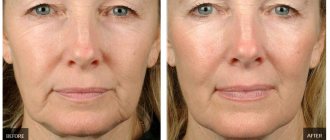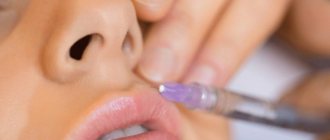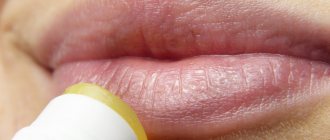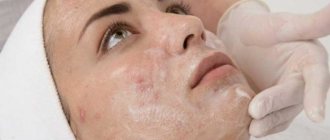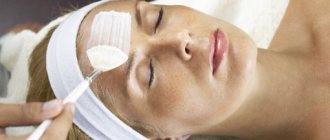Phenol facial peeling: what is it?
Under phenol peels
refers to skin exfoliation procedures performed using carbolic acid (phenol).
Traditional components of phenol peeling compositions are:
• phenol • glycerin • propylene glycol • oil, which accelerates the absorption of carbolic acid into the epidermis • distilled water
Depending on the degree of phenol concentration in the peeling preparation used, the following are distinguished:
• drugs for mid-superficial action (3% carbolic acid) • drugs for medium action (25% carbolic acid) • drugs for deep action (more than 35% carbolic acid)
One of the features of phenol peeling is its high toxicity. Therefore, deep phenol exfoliation is recognized as a dermatosurgical procedure that requires the unconditional skill of a specialist doctor. Deep phenol peeling is performed only after a thorough medical examination of the kidneys, liver and cardiovascular system, under intravenous anesthesia, with cardiac monitoring, accompanied by an anesthesiologist.
Deep peeling affects all layers of the epidermis, right down to the papillary layer. The extreme length of the rehabilitation period, reaching 12 months in some cases, and the high risk of severe complications require a particularly careful approach.
Despite the fact that phenol peels are often called the “gold standard” of aesthetic medicine and the most radical non-surgical method for eliminating wrinkles, recently, in accordance with the recommendations of the scientific community, deep phenol peels are performed only on small, most affected areas of the skin. In other areas, they are limited to median exfoliation.
For purely cosmetic purposes, phenol peeling is recommended only in cases where there is no other alternative. For example, in situations where the patient has a complex cosmetic defect that seriously impairs the quality of life. At the same time, absolute contraindications for the use of laser treatment and dermabrasion have been identified.
Complications and side effects
Exfoliation with phenolic acid in case of non-compliance with the cosmetologist’s recommendations for preparing and caring for the skin after cleansing, or the cosmetologist’s violation of the procedure protocol, threatens the patient with unpleasant effects. Among them:
- Hyperpigmentation – may go away over time, depending on the type and structure of the skin;
- Deformation, sagging of the lower eyelid (ectopia);
- Residual marks from a chemical burn, particularly around the lips and eyes;
- Redness on the face that does not go away until 4 months;
- Increased herpes, manifestation of various infections;
- Problems with the heart and kidneys;
- There is a noticeable difference between areas that were exposed to acid and untouched ones.
The phenol peeling procedure will restore youth and elasticity of the skin without surgery. However, before you agree to perform it, weigh the pros and cons, get examined and get ready for a long period of rehabilitation, followed by many years of beautiful and perfectly smooth skin.
Indications and contraindications for phenol peeling procedures
Indications for the use of phenol peeling:
• the presence of serious age-related changes in the form of deep wrinkles and folds • photoaging • the presence of significant hyperpigmentation • tissue scarring • the need for recovery after serious surgical interventions accompanied by lumpy scars • finely wrinkled type of aging • sagging skin • severe damage to demodicosis • severe damage to acne
Contraindications in this case include:
• age under 18 years • pregnancy • lactation • presence of burns • exacerbation of herpetic disease • presence of cardiovascular diseases • presence of IV-VI phototype of the skin according to Fitzpatrick • individual intolerance to the components of phenol peeling • diabetes mellitus • presence of cancer • presence of skin diseases (eczema, psoriasis, atopic dermatitis) • menstrual period • the presence of elevated body temperature, regardless of the cause • infectious diseases • mental illnesses • thyroid pathology • periods of intense insolation • individual meteosensitivity • the need to take isotretinoin in the next 6 months preceding the peeling procedure • the presence of kidney disease and liver • fungal diseases • violation of the integrity of the epidermis • any trauma in the area of intended treatment • the presence of numerous nevi • hypertrichosis • tendency to keloid scars • impaired skin sensitivity
A conditional contraindication is considered to be age over 60 years, due to the fact that in older people the activity of liver enzyme systems is significantly reduced.
Complications and side effects
Exfoliation with phenolic acid in case of non-compliance with the cosmetologist’s recommendations for preparing and caring for the skin after cleansing, or the cosmetologist’s violation of the procedure protocol, threatens the patient with unpleasant effects. Among them:
- Hyperpigmentation – may go away over time, depending on the type and structure of the skin;
- Deformation, sagging of the lower eyelid (ectopia);
- Residual marks from a chemical burn, particularly around the lips and eyes;
- Redness on the face that does not go away until 4 months;
- Increased herpes, manifestation of various infections;
- Problems with the heart and kidneys;
- There is a noticeable difference between areas that were exposed to acid and untouched ones.
The phenol peeling procedure will restore youth and elasticity of the skin without surgery. However, before you agree to perform it, weigh the pros and cons, get examined and get ready for a long period of rehabilitation, followed by many years of beautiful and perfectly smooth skin.
Many consider phenol peeling one of the most effective procedures for skin rejuvenation. Others argue that it causes more harm to the body than good due to the toxicity of the drug used.
Before agreeing to such peeling or categorically refusing it, it is worth studying the principle of the action of the main component - carbolic acid.
Phenol (or carbolic acid)
- a powerful antiseptic that is used in medicine in the form of a 5% solution. It is absorbed almost instantly into the skin and in high concentrations is very toxic: the acid affects the nervous system and can cause serious poisoning.
Due to its aggressiveness, the acid has a quick and serious effect. When applied to the skin it causes.
This leads to renewal of the upper layer of the dermis and also accelerates the process of collagen formation.
As a result, the epidermis becomes more toned and less susceptible to external negative factors.
Types of peeling
In cosmetology, acid is used in doses in different concentrations.
For superficial exfoliation, a 3% solution is used, for medium exfoliation - 25%, and for deep exfoliation - 35%.
It is better to carry out such peeling permanently, and not at home.
A specialist can accurately determine the required acid concentration.
The session is terminated if the slightest side effects occur.
Photos before and after
Advantages and disadvantages
On to the pros
phenol exfoliation include:
- Long-term effect;
- Noticeable result;
- One-time execution.
Cons
the phenol method has more. Among them:
- Long recovery period;
- Painful sensations;
- The need for pain relief;
- Toxicity of the drug, which puts a serious burden on the entire body;
- Large list of contraindications.
Indications and contraindications
Among the problems that phenol exfoliation combats:
- , including deep ones;
- Flabbiness and decreased elasticity of the skin;
- Photoaging and;
- Scarring;
- Keratosis;
You should refrain from performing phenol exfoliation if you have the following contraindications:
- Age restrictions (peeling is not carried out for people under 18 and over 60 years old);
- and lactation period;
- Herpes in the acute stage;
- Diseases of the cardiovascular system, thyroid gland, kidneys, liver, diabetes, oncology;
- Fungal and infectious diseases;
- Hypertrichosis, skin diseases;
- Injuries, any damage to the integrity of the epidermis in the treatment area;
- Fever;
- Period of menstruation;
- Mental disorders.
Phenol exfoliation is also not carried out if there is an individual intolerance to the components of the drug, if the epidermis is prone to scarring, after a strong tan.
Features of phenol removal from the body
Diseases of the internal organs are a contraindication to phenol exfoliation, since it is quite difficult for the body to remove carbolic acid.
After application to the skin, phenol also has an effect on the intestines: the substance is absorbed, and then processed by the liver and excreted from the body through the kidneys.
Phenol is broken down into harmless metabolites in the liver, but its dysfunction can disrupt this process and thereby slow down the elimination of the toxin.
That is why before phenol peeling it is necessary to undergo a full medical examination to exclude side effects.
Pros and cons compared to other types of peeling
pros
• the ability to carefully control the application of the composition • the presence of the most pronounced anti-aging and therapeutic effect in comparison with all other types of peelings • the presence of a prolonged result that lasts for 7-10 years; • one-time procedure
Photos before and after phenol peeling
Results of phenol peeling
The positive visual effect after deep phenol peeling lasts about 10 years, and it consists of:
• in the normalization of skin functions • in a significant rejuvenation of the skin (according to some data for 5-15 years) • in a significant improvement in the structure of the skin: it becomes smooth, fresh, elastic, elastic, light, tender • in the elimination of age spots • in the elimination of deep wrinkles and scars • in the elimination of small facial wrinkles • in increasing the overall skin tone • in activating the systems of the human body at the microcircular, neural, humoral levels
Minuses
• the presence of a huge list of contraindications • the presence of a very long rehabilitation period (after superficial exfoliation it can be about two weeks, and after deep exfoliation it can reach 12 months) • the need for a thorough preliminary medical examination • the need for serious pre-peeling preparation • placing a significant load on the cardiovascular and excretory body systems • painfulness of the procedure • the need for anesthesia (for superficial exposure - local anesthesia, for deep exfoliation - intravenous anesthesia) • the need for cardiac monitoring during the procedure • the risk of severe complications
Peeling review
Valentina:
“I started thinking about phenol peeling when deep wrinkles and signs of skin aging appeared. Before this, homemade peelings and cosmetics were available, but the moment came when it was necessary to choose. Since plastic surgery was not justified for me, I chose peeling. All my friends have already undergone this procedure and recommended a specialist who does a good job.
After the procedure, I came to my senses for several days. Swelling and pain appeared, but everyone insisted that this was temporary and a normal reaction to the procedure. She took medications to relieve pain.
And over time, after about a week, the skin began to return to normal. All the effects of the peeling went away after a few weeks, and the mask was completely removed, the crust fell off, and after a while the redness went away. And when I saw the result, I realized that all the torment was worth the effect. Pigment spots and wrinkles disappeared, the skin became young and soft. This is exactly the effect I expected.”
Properties of the active component
Phenol (Carbolic acid)
, hydroxybenzene, carbolic acid - the simplest representative of the class of phenols, volatile, has a persistent strong odor.
When in contact with the skin, phenol provides exfoliation, stimulation of the synthesis of glycosaminoglycans, as well as proteins, which is the key to increasing the elasticity, strength and firmness of the epidermis. This leads to a significant improvement in the condition of the skin: visually it looks more uniform, smooth, fresh and toned.
Phenol (carbolic acid) is recognized as a very toxic substance. Carbolic acid easily overcomes the skin barrier and enters the body; after just a few minutes, its effect on brain tissue is observed, as well as absorption into the intestines. In this case, there is a disruption in the functioning of the central nervous system, irritation of the mucous membranes and respiratory tract, convulsions, cyanosis of the skin, and confusion. However, this substance does not manifest itself as a carcinogen.
Upon completion of absorption from the intestine, carbolic acid enters the liver, where, under the influence of enzyme systems, it is decomposed into harmless soluble metabolites, which are excreted from the body by the kidneys. This mechanism for removing phenol from the body does not allow it to accumulate and demonstrate delayed toxicity. It should be realized that phenolic compounds are also produced by the human body itself as a result of the breakdown of tyrosine, which indicates its ability to neutralize and promptly remove phenol.
Due to the fact that the kidneys and liver are responsible for removing phenol from the body, they require a thorough examination before the procedure. In addition, carbolic acid can cause cardiac arrhythmia, so deep phenol peeling is certainly accompanied by cardiac monitoring.
The scientific basis for the development of phenol peeling protocols is a study conducted by biochemists Tretman and Helen-bye. They proved the existence of a relationship between the degree of toxic effects of carbolic acid, its concentration in the drug, the area of the treated skin and the speed of application of the drug.
In particular, it was found that when carbolic acid is slowly applied to small areas of the face, it does not have a significant toxic effect, since with slow exposure the liver manages to partially neutralize the phenol. A quick treatment of the entire surface of the body with just a 2% solution of carbolic acid can lead to death.
It should also be taken into account that taking certain medications may increase the toxic effects of phenol peeling. In particular, aspirin and some other drugs are neutralized in the liver through the same enzymes as carbolic acid. Therefore, performing peeling while taking such drugs can create a significant load on the liver, significantly slow down the metabolization of phenol and lead to poisoning.
Operating principle and effectiveness
Phenol facial peeling is designed to rejuvenate already mature skin and improve facial contour. Based on the name, it is clear that the active ingredient for the procedure is phenol (carbolic acid), which quickly dissolves in water and has an alkaline reaction.
Several years ago, surgeons’ hands were treated with this acid before surgery, until they noticed the harmful effects of phenol on the human body.
Now in cosmetology this substance is used in small concentrations as a resorption and cauterizing drug.
Carbolic acid has strong effects on the skin, namely:
- Strengthens the walls of blood vessels;
- Promotes the formation of new skin cells;
- Reduces inflammation;
- Renews the horny epidermal layer, due to the fact that it causes severe peeling.
- Disinfects the skin;
- Suppresses enzymes that break down hyaluronic acid, thereby rejuvenating the dermis.
Phenol peeling also has the following components:
- Distilled water - acts as a solvent for phenol;
- Glycerin – restores the water balance of the epidermis;
- Propylene glycol – promotes the destruction of sulfide bonds;
- Essential oils help speed up the healing of the dermis.
Here's what you need to know about this type of peeling:
- The effect is immediately visible and does not require cleaning several times.
- It is easy to control the step-by-step application of the solution to the skin;
- A worthy alternative to plastic surgery, also taking into account the fact that after surgery, cells are not renewed as well.
Significant “disadvantages” are:
- Unpleasant painful sensations during the session;
- Long preparation and a short period of skin recovery;
- Mandatory anesthesia;
- The risk of negative effects of the components of the cleaning mixture on the functioning of human internal organs.
Important: there is a danger of scars, hyperpigmentation and skin infection if the technology of applying the phenol mixture is incorrect or if the face is not properly cared for after the procedure.
Pre-peeling preparation
Preparation for phenol peeling involves the following steps:
• medical examination of the kidneys, liver, and cardiovascular system • treatment of the skin with bleaching agents (weak acid solutions) for 5-7 weeks. The skin unprepared in this way will be damaged to varying depths during phenol peeling, which entails the risk of developing hyperpigmentation • oral intake of angioprotectors and antioxidant drugs for 2-3 weeks • discontinuation of external and internal use of aromatic retinoids 6 months before the peeling procedure. It should be remembered that the mentioned drugs enhance the exfoliation of the epithelium, which leads to a significant increase in the depth of penetration of phenol and can cause both excessive burns and hyperpigmentation • stopping any traumatic procedures (epilation, mechanical cleaning, shaving) 10 days before peeling • stopping carrying out laser procedures, mechanical dermabrasion, as well as median exfoliations 6 months before phenol peeling • notifying the doctor performing the peeling procedure about all medications taken on a regular basis • excluding resort holidays and visits to the solarium 3 months before peeling
Stages of phenol peeling
Since phenol vapors are toxic, procedures using it are carried out in well-ventilated areas equipped with fume hoods.
Due to the toxicity of the active component, deep phenol peeling is performed on small areas of accumulation of deep wrinkles, acne, stretch marks and scars. In this case, the remaining areas are subjected to median exfoliation. Carbolic acid is not used in areas prone to the formation of keloid scars (arms, chest, neck, inner thighs).
The main stages of phenol peeling:
• intravenous anesthesia by an anesthesiologist (for deep peeling) or local anesthesia (for medium and superficial peeling). Local anesthesia is usually performed with 2% lidocaine. It should be remembered that increasing the dose of the anesthetic increases the toxicity of phenol, since both of these drugs are transformed in the liver through the same enzymes, and also increases the risk of complications in the form of AV block (a type of heart block that indicates a violation of the conduction of electrical impulses from the atria into the ventricles) and stopping breathing • removing makeup using a rough sponge followed by thorough drying of the skin • degreasing the skin using alcohol to eliminate contaminants • applying a phenolic preparation in smooth and uniform strokes. In this case, the interval between treatments of individual zones should be more than 5 minutes • neutralization of carbolic acid using a special film mask, after drying of which a neutralizing substance is applied to it • application of sunscreen
The duration of the procedure is 40-120 minutes, depending on the individual characteristics of the patient’s skin.
Description of the procedure
So why, despite all the riskiness of this procedure, does it still remain popular? There are actually several reasons.
Firstly, the results after it are truly amazing. The changes are noticeable to the naked eye, even deep wrinkles are smoothed out, the oval of the face is tightened, and age-related pigmentation disappears.
Secondly, the procedure has a prolonged effect. It can last up to 10 years, sometimes even longer, but this depends on the individual characteristics of the dermis.
Thirdly, unlike many other peelings, this type involves a one-time repetition, and not a course, that is, you do not have to do it multiple times to achieve a full result.
Deep phenol peeling should be carried out exclusively by a competent specialist and under the supervision of doctors, including an anesthesiologist.
At the same time, there are also points that can be called negative features of phenol peeling:
- it is painful;
- requires long-term rehabilitation;
- has a very high cost (up to 100 thousand);
- the full result will not be noticeable immediately, but only about a year after the session;
- the procedure permanently eliminates the possibility of sunbathing;
- may lead to unpredictable consequences.
It is important to note that deep and medium phenol peeling cannot be performed at home. And among the superficial ones there are safer and more effective options.
Post-peeling skin care
Upon completion of the procedure, patients experience a noticeable burning sensation in the treated areas. For unbearable pain, it is recommended to use painkillers.
On the first day, you should avoid getting water on the skin, as it enhances the penetration of phenol and can contribute to the occurrence of additional uncontrolled burns. For this reason, you should only drink through a straw and avoid brushing your teeth.
On the second day after completion of the procedure, the film mask is removed along with dead skin particles, revealing the bright red renewed surface of young skin. Its contact with water is still unacceptable.
Starting from the second day, the formation of a superficial tightening crust is observed on the skin, for which external use of panthenol in the form of a spray is prescribed. Attempts to forcefully remove crusts should be completely avoided, as this can lead to the development of scars and hyperpigmentation.
Complete recovery after superficial and relative recovery of renewed skin after deep phenol peeling occurs approximately on the 10-14th day. Starting from this period, the patient can appear in society. In this case, the process of skin maturation after deep peeling is completed in approximately 7-12 months. Painful redness goes away approximately 2 months after completion of the procedure. Throughout this period, panthenol in the form of a spray is recommended for use.
The use of foundation is allowed 3 weeks after peeling.
Tanning is prohibited throughout the year, both in a natural environment and in a solarium.
For post-peeling care, doctors prescribe the following:
• whitening agents • sunscreens with SPF 50+ • moisturizing complexes based on hyaluronic acid • antioxidants • vitamins A and C taken internally, as they enhance the effect of whitening agents
The need for such post-peeling care remains for at least six months.
Indications for use
Phenol peelings are the most radical type of skin cleansing and rejuvenation, which does not require surgical intervention, but is performed by exposing the epidermis to a chemical composition.
To carry out the phenol procedure, it is important to have the following indications:
- Disadvantages of facial relief (deep expression and age wrinkles, stretch marks, scars after surgery);
- Rapid withering of the skin, loss of turgor and tone;
- Symptoms of photoaging of the skin;
- Hyperpigmentation on the face, residual marks after sunburn;
- Consequences of acne, demodicosis;
- A number of dermatological diseases (certain types of keratosis).
Phenol peeling is a confident step to restore the youth of your face. Rest assured, you will experience renewed skin that is soft and supple. The face becomes perfectly smooth and toned, just like 10 years ago. At the same time, the active synthesis of your own collagen and elastin is launched, so the result lasts for another ten years.
Possible complications after phenol peeling
• high risk of cardiac arrhythmia, liver and kidney failure • third degree burn, requiring lifelong protection of the epidermis from UV radiation • exacerbation of herpetic disease • allergic reactions • decreased immunity • infectious, fungal, viral diseases • the emergence of sharp boundaries between treated and untreated areas (typical for those with dark skin) • hyperpigmentation in case of dysfunction of the liver and kidneys, as well as in the presence of oily skin • formation of milia (“grass”) • formation of keloid scars • loss of the skin’s ability to produce pigment. It should be understood that freckles in this case do not return, lifelong protection from UV radiation must be provided, otherwise there is a risk of developing hyperpigmentation and skin cancer • pathological increased sensitivity of the skin • the occurrence of persistent swelling of soft tissues (for more than 72 hours) • exacerbation of various skin ailments such as acne, seborrheic dermatitis, rosacea • the occurrence of atrophic changes in the skin • the appearance of persistent facial erythema • the formation of depigmented zones on the skin • the occurrence of hyperkeratosis • the appearance of enlarged pores
Side effects
The development of complications is the result of insufficient post-peeling care or the omission of any contraindication.
The most common consequences include:
- exacerbation of herpes;
- immune system disorders;
- hyperkeratosis;
- burn;
- swelling;
- soft tissue atrophy;
- loss of the skin's ability to produce melanin;
- dermatitis (contact/allergic);
- scar formation in the periorbital/perioral zone;
- persistent redness (lasts up to six months);
- keloid scars;
- “marbling” of the skin (in women with very dark skin, a dividing line may appear, outlining the zone of exposure to the chemical).
Cost of phenol peeling
The average cost of a phenol peeling procedure: superficial - from 3,000 rubles; middle - from 20,000 rubles; deep - from 100,000 rubles.
Tags: other
Market Analytics
- Black Lives Matter movement: reaction and consequences for the beauty industry
- COVID-19 is changing the rules of the game in the cosmetics market
- Beauty of the future: cosmetic innovations 2020
Convenient search for beauty salons on our website
Beauty salons in Moscow Beauty salons in St. Petersburg Beauty salons in Ekaterinburg Beauty salons in Novosibirsk
Latest blog posts on our website
- Naturecream / Apricot kernel oil for face
- Naturecream / MATRIXYL3000 - the best skin elasticity stimulator
- Naturecream / SPF in Natural Oils
- Naturecream / Geranium (Pelargonium) oil for skin health and beauty
- Prostye-sovety / Save on a beauty salon: procedures that can be done at home
- Naturecream / Growth Factor - brings back youth?
- Oksana-Lezina / 3 effective abdominal exercises from a fitness instructor for beginners
- Prostye-sovety / Making perfect curls at home
- Prostye-sovety / Which hair removal method to choose
- Naturecream / Wrinkles Puppets
Latest forum topics on our website
- Natalya / How to properly make a gelatin mask?
- Mrs._Smith / Badly sunburned! What to do?((
- Ice / Is it necessary to combine fitness classes with a diet?
- Antonova / What can be used for hair loss?
- Radio operatorKat / Who was on a protein diet?
Reviews about the procedure
Phenol facial peeling [Leave a review]
Leave your feedback about this procedure (it will appear on this page after moderation)
In this form, describe only
your personal
experience of undergoing the procedure.
In order to leave a comment regarding the content of the article, use another form - in the “comments” block at the bottom of the page.
Other articles in this section
| Homemade facial peeling Homemade facial peeling, of course, will not replace procedures with a cosmetologist, but it will help keep your skin in good condition. Let's see how you can do facial peeling at home using professional preparations and products that you can prepare at home. |
| Antioxidant peeling Sun Peel (Sun peeling) for the face Many representatives of the fair sex have overly sensitive skin, so in the summer, pigment spots appear on the face. In order to refresh the skin, give it radiance and get rid of hyperpigmentation, doctors recommend using safe antioxidant peeling Sun Peel. |
| Diamond facial peeling: what you need to know about the procedure Age-related changes, traces of acne, pimples, age spots clearly do not decorate our face. Every woman strives to look young and beautiful. Cosmetic procedures help her with this. One of them is diamond facial peeling. With it you can “erase” all noticeable skin defects. In the article, we will consider who the procedure is indicated for, find out its positive and negative aspects, the technology of its implementation and possible side effects. |
| ABR peeling for the face ABR peeling is a combined medium peeling that is used mainly for oily problem skin. This is one of the best remedies for correcting post-acne and stagnant spots. ABR peeling refers to the process of skin exfoliation under the influence of drugs with the following active ingredients: A – AHA (alpha hydroxyl acids); B - BHA (beta-hydroxy acids); R – vitamin A (retinol). |
| Peeling with gluconolactone for the face Peeling with gluconolactone is a relatively new type of superficial chemical peeling. It has more pronounced moisturizing properties compared to AHA. The gluconolactone molecule penetrates the structure of the skin more slowly, which avoids the burning sensation that often appears when using other active ingredients. Therefore, peeling with gluconolactone is recommended for people with very sensitive skin. |
| Azelaine peeling for the face Azelaine peeling is a procedure for superficial chemical cleansing of the facial skin, prescribed to patients with dermatological problems: rosacea, acne, rosacea and other pathological changes in the skin. Azelaic acid has a bacteriostatic effect against the mite that causes acne. |
| Microcrystalline dermabrasion (mechanical peeling) for the face In the fight for an impeccable appearance with smooth, satiny skin, without scars, stretch marks and other unaesthetic defects, many methods have been invented. Microcrystalline dermabrasion or mechanical peeling is one of them. It is quite effective and is able to cope with defects such as scars, scars and stretch marks, and also has all the properties of mechanical peeling. |
| TCA peel or trichloroacetic acid peel for the face TCA peel is a type of chemical peel that affects the middle layers of the epidermis. At the same time, the skin is cleansed at sufficiently deep levels. This peeling is carried out using trichloroacetic acid (TCA), a highly toxic analogue of acetic acid that is absorbed through the skin and has a pronounced bactericidal, anti-inflammatory and cauterizing effect. |
| Almond peeling for the face Almond peeling is a superficial chemical peeling, which is considered one of the most gentle. The use of peeling with mandelic acid is also possible in the summer, since it does not have photosensitizing effects. It is suitable for people with different skin types, including very sensitive, thin skin. |
| Laser facial peeling Laser peeling, performed on the facial skin, is one of the physical rejuvenation techniques. It is based on the use of monochrome light radiation, which is a single wavelength, which, when exposed to tissue, leads to selective photothermolysis. As a result of this reaction, over 95% of the laser radiation energy is absorbed by one target tissue and is further converted into heat. As a result, the patient experiences selective evaporation of layers of skin, which makes it possible to remove age spots, acne scars, expression lines and some other skin defects. |
